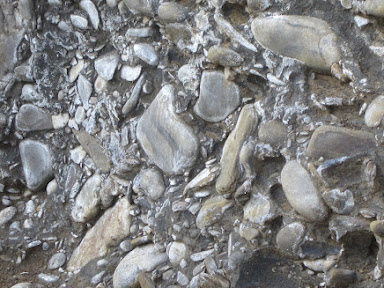In several journal articles recently I have encountered variations on this statement: "The raised beach contains erratic pebbles, demonstrating that at the time of its formation glacier ice was active in the vicinity." How weird is that?
Let's just look at the present-day storm beaches and quiet water beaches of Pembrokeshire: Poppit, Ceibwr, Parrog, Newport, Abermawr, Druidston, St Brides, Manorbier, Dale, West Angle, and so on and so on. Hundreds of beaches. They ALL contain erratic cobbles. The percentages are not very high -- maybe up to 10% in places. But I defy anybody to name a beach in Pembrokeshire that does NOT contain far-travelled erratic materials.
The explanation is simple. Beaches are generally built of clasts derived from adjacent bedrock outcrops and exposures of unconsolidated sediments. Those sediments include till, glaciofluvial sands and gravels, slope breccia and silts and clays derived from past glacial and periglacial episodes. They are ubiquitous -- found on all of the coasts regardless or orientation of configuration. Because they are unconsolidated, they are easily destroyed by wave action across quite a wide tidal range, and incorporated into beach materials. Because of the Holocene sea level rise, and because the sea has been advancing at the expense of the land, there is an "accumulator effect" seen at its most spectacular in Newgale, where the storm ridge has marched eastwards for many thousands of years, incorporating glacial and glaciofluvial deposits from locations now several miles offshore.
So let's move to the raised beaches. There are plenty of them -- for example at Poppit, Ogof Golchfa, Abermawr, Broad Haven South, Ragwen Point, and Ballum's Bay.


No comments:
Post a Comment